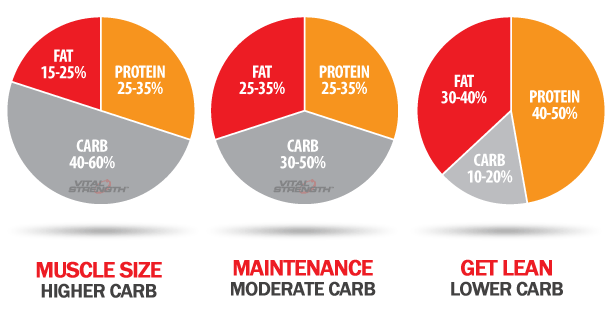If you care at all about weight loss, muscle growth, overall health or anything similar, then you probably know your diet is key. While there are many factors dictating whether your diet will be successful (both in terms of its effectiveness and your ability to actually sustain it), the two most important factors are always going to be:
- Your calorie intake.
- Your macro-nutrient intake (aka macros).
I’m going to show you exactly how to calculate your macros for an effective weight loss or muscle gain diet. It’s going to be quick and easy, I promise. What Are Macros?
“Macros” is an annoyingly overused abbreviation for the word “macro nutrients,” which are the nutrients that provide the calories in the foods we eat. There are four of them, although it’s the first three that will be getting the majority of our attention:
- Protein. (1 gram = 4 calories)
- Fat. (1 gram = 9 calories)
- Carbs. (1 gram = 4 calories)
- Alcohol. (1 gram = 7 calories)
So when you look at the nutritional information of a food and see the amount listed for “Calories,” that amount is the total combined calories from the protein, fat and carbs (and alcohol) in that serving of that food.
When you see the word macros over and over and over, again, this is all it’s referring to. Protein, fat and carbs. Pretty simple so far, well, hang on, because that’s all about to change!How To Calculate Your Macros: The Two Options
Now that you know what macros are, it’s time to figure out how to calculate how much of each you should eat per day. To do this, you have two options.

1: The Unnecessary Way
This option involves finding yourself what I think can best be described as a Social Media Diet Coach, one who provides some kind of “custom macro service” where they will “custom design your macros for you” and “custom tailor” them to the needs and goals of your diet.
In return, of course, you’re going to have to pay them. I’ve seen many professional diet coaches… charging hundreds for their “Custom Macro Plans.” Sometimes they even make you pay a recurring monthly fee so they can continue to “customise” your macros from that point on. Let me show you how to do this yourself!
2: The Smart Way
This is the option you choose when you realise how laughably overpriced and completely unnecessary the first option is and how fast, simple, easy and free it would be to just calculate your macros yourself. All it takes is a simple 5-step process, and it starts right now…
1. Determine Your Ideal Calorie Intake:

Your calorie intake is always going to be the most important part of your diet regardless of whether you want to lose fat, build muscle/gain weight or simply maintain your current weight.
Since macro-nutrients are what provide these calories, your macros will need to be calculated based on what your ideal calorie intake is. That’s why the first step in this process is always going to be figuring out how many calories you need to eat per day for your specific goal. Once you know that, the rest is easy.
So, if you already know what your ideal calorie intake is, you’re good.
2. Calculate Your Protein Intake:
After calories, the next most important part of your diet (and the most important macro-nutrient) is protein.
A sufficient protein intake is crucial for the overall health and function of the human body, is a requirement of building muscle, is a requirement for maintaining muscle while losing fat and will play major roles in terms of hunger and appetite control, increasing the thermic effect of food (aka the calories your body burns during digestion) and more.

The ideal daily protein intake for most people trying to lose weight or gain muscle is between 0.8-1.3 grams of protein per pound of their current body weight. Whenever in doubt, an even 1g per pound is a fine place to start. (Those who are significantly overweight should use their goal body weight rather than their current body weight when doing this calculation.)
So, if you currently weigh 180lbs, you could aim for an even 180g of protein per day, or aim for some degree higher or lower depending on your own personal needs and preferences (as long as you stay within this range, you’ll be fine).
- Eating too much protein isn’t bad for you.
- Your body can absorb more than just 20-30g of protein at a time.
Try to get most of your daily protein intake from higher-quality sources you enjoy and don’t have any issues digesting. Common examples includes:
- Chicken.
- Turkey.
- Eggs.
- Beef.
- Fish.
- Dairy.
- Whey protein powder.
And just like that… one of your macros have been calculated and “custom designed.”
3. Calculate Your Fat Intake:
Next up in terms of importance is fat.
A sufficient fat intake is also crucial for the overall health and function of the human body in a variety of ways, including the absorption of fat soluble vitamins and optimal hormone production (e.g. testosterone). In addition, it helps with satiety and tends to make food taste better, which is nice.
The ideal daily fat intake for most people trying to lose weight or gain muscle is between 15-35% of their total daily calorie intake. Whenever in doubt, an even 25% is a fine place to start.
So, for example, let’s say someone determined that they need to eat 2000 calories per day (this is just a random example). Let’s also say they decide to go with an even 25% of their total calories from fat.
First, they’d take 25% of 2000 and get 500. Then, since there are 9 calories per gram of fat, they’d simply divide 500 by 9 and get 56g of fat per day.
You’d simply repeat this using your own relevant numbers and let your personal needs and preferences dictate exactly where within this ideal range you decide to be so that your diet is as enjoyable and sustainable for you as possible.

Try to get most of your daily fat intake from higher-quality sources you enjoy and don’t have any issues digesting. Common examples include:
- Various nuts.
- Seeds.
- Nut butters.
- Olive oil.
- Coconut oil.
- Fatty fish (e.g. salmon).
- Avocados.
Also try to aim for a good mix of saturated, monounsaturated and polyunsaturated fats, with an extra added emphasis on getting a sufficient amount of the omega-3 fatty acids (a fish oil supplement can come in handy there) and avoiding trans-fat.
That’s two macros down… one to go.
4. Calculate Your Carb Intake
And finally, we have the least-important-but-still-important carbs.
A sufficient carb intake – while much less important for sustaining life and proper function compared to protein and fat – will still be crucial for your training performance and recovery, as well as your ability to generally be a happy person who doesn’t hate their diet and feel rubbish all the time because they’ve restricted their carb intake unnecessarily low.
The ideal daily carb intake for most people trying to lose weight or gain muscle is simply whatever calories are leftover after protein and fat intake have been factored in.
Here’s an example of how this would be done…
Let’s pretend we have a random example person who weighs 175lbs and has figured out that they need to eat 2500 calories per day for their goal. (Again, these are just example numbers.)
Then let’s say they go with an even 1 gram of protein per pound of body weight. Since they weigh 175lbs, that means they’ll eat about 175 grams of protein per day. Since 1 gram of protein contains 4 calories, that means their protein intake will account for 700 calories each day (175 x 4 = 700).
Next let’s say they decide to get an even 25% of their total calorie intake from fat. Since this example person will be eating 2500 calories per day, they’d figure out that 25% of 2500 is 625 calories (2500 x 0.25 = 625). Then, since 1 gram of fat contains 9 calories, they’d figure out that they’d need to eat about 69 grams of fat per day (625 ÷ 9 = 69).
At this point they have 700 calories worth of protein and 625 calories worth of fat, which means a total of 1325 of their daily calorie intake is accounted for (700 + 625 = 1325). But, since they need to be eating 2500 calories per day, they’d see they still have 1175 calories that are not yet accounted for (2500 – 1325 = 1175). So…
All of those leftover 1175 calories will come from carbs. Since 1 gram of carbs contains 4 calories, this person would need to eat about 294 grams of carbs per day (1175 ÷ 4 = 294).
You’d simply repeat these steps using your own relevant numbers.
Try to get most of your daily carb intake from higher-quality sources you enjoy and don’t have any issues digesting. Common examples include:
- Fruits.
- Vegetables.
- Rice.
- Potatoes.
- Oats.
- Beans.
5. Adjust For Enjoying And Sustainability
The previous four steps (calculating your calorie, protein, fat and carb intake) are going to be the key dietary steps for weight loss and muscle growth. Having said that, there are still other factors that will play a direct role in your ability to actually put those key dietary factors into action, stick to it all on a consistent long-term basis.
This final step is all about adjusting those factors to make it happen. Specifically in terms of macros, this would mean adjusting exactly where you choose to be within the recommended guidelines laid out in this article.
For example, do you prefer a slightly higher or lower carb diet? Or a slightly higher or lower fat diet? Or a slightly higher or lower protein diet?
If so, that’s all perfectly fine. Because…
As long as you stay somewhere within the recommended ranges given for each macro-nutrient and always ensure your total calorie intake remains what it needs to be for your goal, you can (and should) feel free to adjust your macros (a little less of this, a little more of that) to suit your personal needs and preferences.
In fact, you should feel free to adjust every aspect of your diet (meal frequency, meal timing, food choices, diet organisation, etc.) in this manner so it’s as preferable, enjoyable, convenient and sustainable for you as possible.


